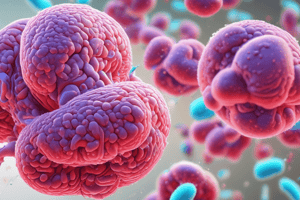Podcast
Questions and Answers
Which test differentiates staphylococci from streptococci?
Which test differentiates staphylococci from streptococci?
Catalase Test
Which microbe species is weakly catalase positive but may not always test positive due to its weak properties?
Which microbe species is weakly catalase positive but may not always test positive due to its weak properties?
Enterococci
How are the Streptococcus species separated into different groups?
How are the Streptococcus species separated into different groups?
Immunologic properties, hemolytic properties, biochemical properties
What is the immunologic classification system used to organize streptococci?
What is the immunologic classification system used to organize streptococci?
Lancefield groupings originally applied only to beta-hemolytic streptococci, but later discoveries extended classification to other non-hemolytic streptococci.
Lancefield groupings originally applied only to beta-hemolytic streptococci, but later discoveries extended classification to other non-hemolytic streptococci.
Lancefield antigens define a particularly virulent group of streptococci regardless of their hemolytic patterns.
Lancefield antigens define a particularly virulent group of streptococci regardless of their hemolytic patterns.
What are the three distinct hemolysis patterns used to separate streptococci?
What are the three distinct hemolysis patterns used to separate streptococci?
Which strep classification utilizes immunologic testing?
Which strep classification utilizes immunologic testing?
__________; using antibodies to identify an unknown organism.
__________; using antibodies to identify an unknown organism.
The commercially available strep typing kits contain vials of ________ directed against the various groups of streptococcal antigens.
The commercially available strep typing kits contain vials of ________ directed against the various groups of streptococcal antigens.
Sequelae resulting from infection with Strep pyogenes include ____________ and __________.
Sequelae resulting from infection with Strep pyogenes include ____________ and __________.
What type of hemolysis does strep pyogenes carry out?
What type of hemolysis does strep pyogenes carry out?
Streptolysin O produced by strep pyogenes has what properties?
Streptolysin O produced by strep pyogenes has what properties?
People with infections caused by strep pyogenes produce _________ in response to the antigens produced by the microbes.
People with infections caused by strep pyogenes produce _________ in response to the antigens produced by the microbes.
What are some other virulence factors produced by strep pyogenes besides streptolysin O?
What are some other virulence factors produced by strep pyogenes besides streptolysin O?
Which organisms are PYR positive?
Which organisms are PYR positive?
Describe the basic science behind a rapid screening test for strep.
Describe the basic science behind a rapid screening test for strep.
The rapid screening test for strep is quite (specific/sensitive) but is lacking in (specificity/sensitivity).
The rapid screening test for strep is quite (specific/sensitive) but is lacking in (specificity/sensitivity).
Flashcards are hidden until you start studying
Study Notes
Identification Tests and Characteristics
- Catalase Test distinguishes staphylococci (positive) from streptococci (negative).
- Enterococci are weakly catalase positive, leading to potential false negatives in testing.
Streptococcus Classification
- Streptococcus species are categorized by:
- Immunologic properties (Lancefield groupings)
- Hemolytic properties
- Biochemical properties
- Lancefield Grouping: Classifies streptococci into groups A to O (excluding I and J) based on carbohydrate antigenic differences in cell walls.
Hemolysis Patterns
- Three groups based on hemolysis:
- Beta-hemolytic: Destroys red blood cells (RBCs), changing hemoglobin into a colorless form.
- Alpha-hemolytic: Causes green/brown discoloration by converting hemoglobin to methemoglobin without lysing RBCs.
- Gamma-hemolytic: Non-hemolytic, showing no effect on RBCs or hemoglobin.
Immunologic Testing
- Lancefield Groups utilize immunologic testing for precise identification of streptococci.
- Serology/Immunodiagnostics: Antibodies are used to identify unknown organisms.
Strep Pyogenes and Its Infections
- Streptococcus pyogenes is linked to multiple conditions: strep throat, scarlet fever, childbed fever, impetigo, septicemia, and necrotizing fasciitis.
- Sequelae from S. pyogenes infections include rheumatic fever and glomerulonephritis.
Hemolysis and Testing Properties
- S. pyogenes exhibits beta hemolysis and is sensitive to bacitracin.
- Streptolysin O is oxygen labile; weak hemolysis may occur under aerobic conditions but can be enhanced by reducing oxygen tension in blood agar.
Antibody Response
- Patients infected with S. pyogenes produce anti-streptolysin O antibodies. A high titer indicates recent or past infection.
Virulence Factors of S. Pyogenes
- Other virulence factors include:
- Streptolysin S: Lyses RBCs and non-erythrocyte cells
- Streptokinase, Fibrinolysin, Hyaluronidase, Proteases
- Erythrogenic toxins: Includes streptococcal pyrogenic exotoxins and exotoxin A
- Deoxyribonucleases
PYR Test Results
- PYR positive organisms include group A streptococci and enterococcus.
Rapid Screening Tests
- A rapid screening test for strep utilizes antibodies bound to a solid matrix to capture streptococcal antigens from a patient sample, followed by detection through colorimetric measures.
Sensitivity and Specificity
- The rapid strep screening test is very specific but lacks sensitivity in identifying all cases.
Studying That Suits You
Use AI to generate personalized quizzes and flashcards to suit your learning preferences.




